Parting Ways with the Big Bang
In September, an article published by Eric Lerner in Asia Times titled “Saying goodbye to the Big Bang” took the scientific world by storm. Lerner argued that vital astronomical evidence, including recent data from NASA’s James Webb Space Telescope, contradicts the Big Bang theory. This forces even previously unwavering supporters of the Big Bang, astrophysicists Adam Frank and Marcelo Gleiser, to acknowledge that there are fundamentally wrong elements within the standard cosmological theory. This has led to the conclusion that key features of the universe’s origin and development may require a radical rethinking.
Based on the work of the Nobel Prize-winning physicist Hannes Alfvén, Eric Lerner elaborates on an alternative theory explaining the universe’s evolution in a three-part series. According to Lerner, the principles accounting for the development of stars, galaxies, and wider-scale structures in the Universe also hold essential clues for revolutionary fusion power production on Earth. Advocating for his company, LPPFusion’s work in the dense plasma focus approach to fusion, Lerner aims to demonstrate a practical, clean, and renewable solution to replace fossil fuels.
The science of the Universe’s evolution, particularly concerning the Big Bang theory’s contradictions, has brought along a deluge of new data emanating from the James Webb Space Telescope and other instruments. If the Big Bang isn’t the answer, what is? Is there an alternative, observation-verified history of cosmic evolution? This raises questions about the relevance of distant cosmic occurrences to the present day. The proposed “plasma cosmology” offers an explanation and negates the need for murky entities such as dark matter, dark energy, and inflation theory.
The universe’s development without the confines of expansion, as proposed by Alfvén and his associates, has been scientifically validated over the past half-century. The theory leverages on physical processes observed in our solar system and on Earth and has been supported by accurate predictions of cosmic phenomena before they were observed. Hannes Alfvén’s groundbreaking work in developing this framework established the critical role of electrically conducting gases – plasmas – in understanding cosmic evolution.
Furthermore, crucial processes explaining the cosmos’ evolution can be leveraged to harness fusion energy on Earth. This offers a chance to phase out fossil fuels and deploy clean, affordable, and infinite energy. This is a strong testament to how sky-bound studies can lead to revolutionary technological progress on our planet.
The detailed approach to studying and understanding the universe’s evolution demands a solid scientific methodology. Over forty years ago, Alfvén emphasized the importance of an evidence-based approach to unravel the grand drama of the cosmos, steering clear of the pitfalls of mythology. He called for a method that leverages observable evidence, tracing the cosmos’ evolution step by step into the past and out into space. Alfvén also highlighted the importance of recognizing that maintaining and forming structures needs to be accounted for just as much as the structures themselves. The traditional bottom-up approach of reductionism can lead to paradoxes when applied to intricate systems, paving the way for structured processes to be given a backseat.
Psyched to dig into the amazing cosmic history till date? Hold your horses! The records for the earliest time we have evidence for stem from observing the universe’s colossal structures. Ground-breaking observations have uncovered vast aggregation of galaxies connected like beads on filaments, spanning tens of millions of light-years and organized hierarchically in superclusters spanning more than 4 billion light-years in radius. These observations then lead to the conclusion that these objects should be about 7 or 8 trillion years old, or about 500 times older than the postulated age of the Big Bang, utterly contradicting the predictions of the Big Bang theory.
Lerner’s articles are a captivating blend of science, history, and promise for the future. It’s a leap of faith into the unknown, into possibilities beyond our imagination while tethered to evidence-based determinism. Whether “plasma cosmology” will supplant the Big Bang, only time will tell. Watch this space!


